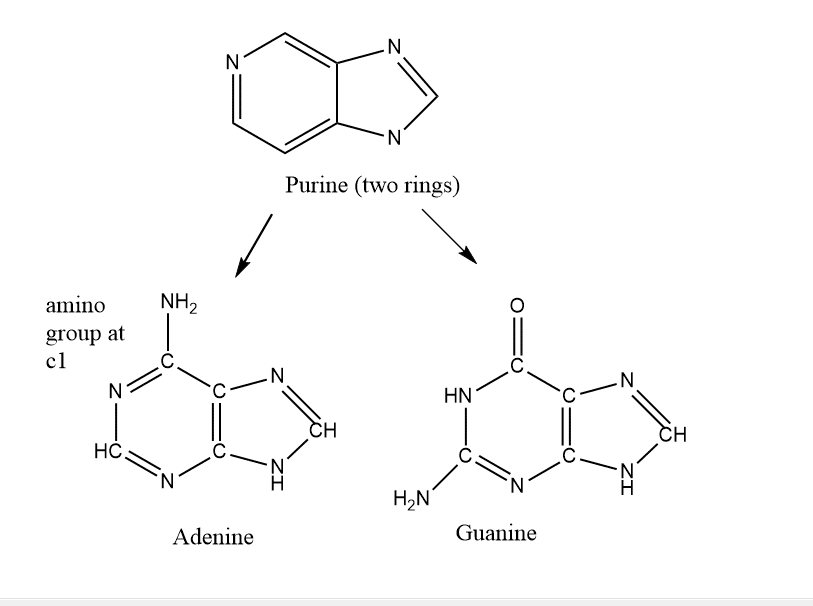Table of Contents
ToggleNucleic acids are biopolymers and macromolecules that are necessary for all known forms of life. They are made of nucleotides, which are monomers made of a nitrogenous base, a phosphate group, and a 5-carbon sugar. Deoxyribonucleic acid (DNA) and ribonucleic acid are the two primary types of nucleic acids (RNA). If the sugar is deoxyribose, the polymer is DNA; if the sugar is ribose, the polymer is RNA.

Nucleic acids definition
Nucleic acids are the natural chemical substances that make up the genetic material and are the main information-carrying molecules in cells. They are made up of nucleotides and nucleosides.
Nucleotides are formed from the combination of pentose sugar+ nitrogenous bases+ phosphate group
Nucleosides are formed from the combination of pentose sugar+ nitrogenous bases and lack phosphate groups.
History of Nucleic acids
Friedrich Miescher made the first discovery of nucleic acid in 1869 at the University of Tübingen in Germany. Nuclein was the first name he gave it. Albrecht Kossel further refined the material in the early 1880s and learned about its extremely acidic characteristics. He later recognized the nucleobases as well. Richard Altmann used the name “nucleic acid” in 1889 because DNA and RNA were not then distinguished.
The initial DNA X-ray diffraction pattern was initially published in 1938 by Astbury and Bell. DNA is the bearer of genetic information, as demonstrated by the Avery-MacLeod-McCarty experiment in 1944, and Watson and Crick’s proposal of the double-helix structure of DNA in 1953.
Properties of Nucleic acids
The major properties of nucleic acid are:
- They are the long chain of nucleotides.
- They are composed of nitrogenous bases, phosphate groups, and ribose sugar.
- Due to base pairing between nucleic acid molecules, nucleic acids can build a double-stranded structure with a corresponding nucleotide sequence, and this reaction is quite specific.
The basic structure of Nucleic acids
Adenine (A), guanine (G), cytosine (C), thymine (T), and uracil are the four nitrogen-containing bases that are present in each nucleic acid out of a possible five (U). While C, T, and U are collectively referred to as pyrimidines, A and G are classified as purines. The nucleotides A, C, and G are present in all nucleic acids; T, on the other hand, is only present in DNA, while U is only present in RNA.
The absence of a hydroxyl group (OH) on the 2′ carbon of the sugar ring distinguishes the pentose sugar in DNA (2′-deoxyribose) from the sugar in RNA (ribose). A nucleoside is a sugar that is joined to one of the bases but does not have a phosphate group.
The phosphate group joins the following sugar residues in the chain by forming a bridge between the 5′-hydroxyl group on one sugar and the 3′-hydroxyl group on the following sugar. Both RNA and DNA include these phosphodiester bonds, which are nucleoside connections.
Generally, nucleic acids are composed of three main components. They are
- Nitrogenous bases
- Phosphate groups
- Pentose sugar
1. Nitrogenous bases:
Nitrogenous bases are found in nucleic acids which are composed of purines and pyrimidines.
Purines:
They are composed of two carbon-nitrogen rings. Examples of purine bases are Adenine, Guanine. Purine bases are attached to specific pyrimidine bases through a hydrogen bond.

Pyrimidines:
They are composed of one carbon-nitrogen ring. Examples of these are Cytosine, Thymine, and Uracil. DNA contains thymine in place of uracil and in RNA instead of thymine, uracil is present as a nitrogenous base. Thymine and uracil are different in structure by the presence and absence of methyl groups. Uracil lacks the presence of a methyl group.

2. Pentose sugar
In DNA and RNA, pentose sugar is found. It can be found in their “furanose” (closed five-number rings) and “configuration” structures. In nucleic acid, there are two different pentose sugar kinds.
- Ribose (present in RNA)
- 2-Deoxyribose (present in DNA)

3. Phosphate group
One of the essential parts of nucleic acids is this. The monovalent hydroxyl groups and one divalent oxygen atom are all joined to the pentavalent phosphorus atom in this substance. The phosphate is esterified to the 5′-carbon and the base is linked covalently (at N9 for purines and N1 for pyrimidines). By removing the components of water, the N-glycosyl bond is created (hydroxyl groups from pentose and hydrogen atoms from the base).

Types of Nucleic acids
The main two types of nucleic acid are :
1. DNA
- DNA stands for deoxyribonucleic acid.
- Discovered in 1869 by Friedrich Miescher a swiss researcher.
- DNA contains genetic material which contains all the information.
- They contain adenine, guanine as purine, and thymine and cytosine as pyrimidine bases.
- DNA is a double-stranded helix proposed by James Watson and Francis Crick.
- The 3-D nature of DNA is described by Astburg using X-ray crystallography.
- They mainly contain nitrogenous bases+ phosphate groups+ pentose sugar.
- The nucleotides in the helix are joined together by a phospho-diester bond.
- The purine base is attached to pyrimidine bases.
- A=T and guanine are attached to cytosine by three bonds.

2. RNA
- RNA stands for ribonucleic acid.
- They are single-stranded helices.
- Each ribonucleotide is composed of nitrogenous bases, a phosphates group, and pentose sugar.
- They contain uracil instead of thymine.
- It helps in protein synthesis.
- They are found as the genetic material of some viruses such as animal viruses, and bacteriophages.


Differences between DNA and RNA
| DNA | RNA |
| Stands for deoxyribonucleic acid | Stands for ribonucleic acids |
| Contains deoxyribose sugar as pentose sugar | Contains ribose sugar as pentose sugar |
| It contains thymine as a pyrimidine base | It contains uracil as a pyrimidine base. |
| It is a double-stranded helix | It is a single-stranded helix |
| It contains a long chain of nucleotides. | It contains a shorter chain of nucleotides |
| DNA replicates on its own, it is self-replicating | RNA does not replicate on its own. |
| DNA is stable under alkaline conditions. | While RNA is not stable. |
Function of Nucleic acids
The function of nucleic acids are:
- It stores genetic information in the biological systems.
- It consists of DNA which helps in storing all the genetic information.
- RNA helps in protein synthesis.
- The instructions required for a creature to grow, endure, and reproduce are encoded in its DNA. DNA sequences must be transformed into messages that can be utilized to create proteins, which are the complex molecules that carry out the majority of the work in our bodies, in order to perform these activities.
- The translation is a major way that RNA makes proteins. RNA transmits genetic information that ribosomes interpret into a variety of proteins required for biological functions. The three primary RNA subtypes involved in protein synthesis are mRNA, rRNA, and tRNA.






